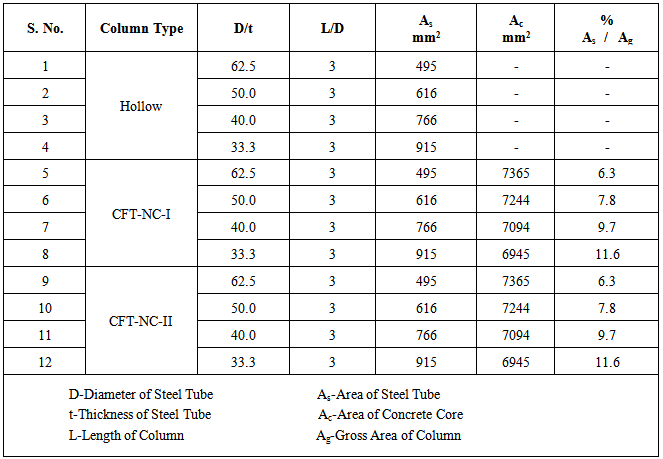-
Paper Information
- Next Paper
- Previous Paper
- Paper Submission
-
Journal Information
- About This Journal
- Editorial Board
- Current Issue
- Archive
- Author Guidelines
- Contact Us
Journal of Civil Engineering Research
p-ISSN: 2163-2316 e-ISSN: 2163-2340
2014; 4(2A): 12-16
doi:10.5923/c.jce.201401.03
Influence of Concrete Confinement on Axial Load Capacity of Concrete-filled Steel Tubes
N. Umamaheswari1, S. Arul Jayachandran2
1Dept. of Civil, SRM University, Kattankulathur-603 203, Kancheepuram District, Tamilnadu, India
2Dept. of Civil, IITMadras, Chennai, Tamilnadu, India
Correspondence to: N. Umamaheswari, Dept. of Civil, SRM University, Kattankulathur-603 203, Kancheepuram District, Tamilnadu, India.
| Email: |  |
Copyright © 2014 Scientific & Academic Publishing. All Rights Reserved.
The confinement offered by steel tubes in Concrete filled Steel tubular (CFT) Columns is found to be crucial in the enhancement of structural properties of such columns. The influence of confinement on axial load capacity is estimated from the results of axial compression tests conducted on twelve cold formed steel circular columns of length to diameter ratio equal to 3 and diameter to thickness ratio ranging from 33 to 63. Eight columns are filled with M30 grade concrete. Four identical columns are kept hollow for comparison purposes. The theoretical axial load capacity values and degree of confinement are estimated using equations proposed by various authors (which is available in literature) and these values are compared to corresponding experimental values. The results showed that axial load capacity of CFTs increases up to 2.2 to 5.5 times that of identical hollow sections and it is found that confinement of concrete core on steel tubes is effective in CFT columns of lesser diameter to thickness ratio and higher steel area contribution.
Keywords: Concrete-filled tubes, Cold-formed Steel, Axial compression, Concrete Confinement, Local Buckling
Cite this paper: N. Umamaheswari, S. Arul Jayachandran, Influence of Concrete Confinement on Axial Load Capacity of Concrete-filled Steel Tubes, Journal of Civil Engineering Research, Vol. 4 No. 2A, 2014, pp. 12-16. doi: 10.5923/c.jce.201401.03.
Article Outline
1. Introduction
- Concrete filled Steel tubular (CFT) Columns are found to be possessing improved structural properties compared to conventional columns due to the composite action of steel tube and core concrete. The confinement effect of concrete core results in triaxial state of stress of concrete core thereby avoids the inward buckling of steel tube and thus increasing the strength and stability of CFT columns. The failure load will be considerably larger than the sum of steel and concrete failure loads. The level of increase in the failure load of CFTs caused by the confining effect of the steel tube on concrete core is influenced by factors such as cross-sectional shape, length to diameter ratio, diameter to thickness ratio or thickness of steel tube, eccentricity of loading, concrete core strength and steel strength [1]. Schneider [2] investigated fourteen short CFT columns to examine the influence of steel tube shape and tube thickness on axial compressive strength of CFT columns and concluded that confinement of concrete core is significant in circular tubes than in square or rectangular tubes. Brauns [3] found that effect of confinement exists at higher stress levels only. Giakoumelis and Lam [4] tested fifteen circular CFT columns to check the effect of steel tube thickness, bond between steel tube and concrete core and concrete confinement on the behavior of CFT columns. An equation is suggested to find Concrete Enhancement Factor to estimate the augmentation of strength of CFT columns. Gardner and Jacobson [5] stated that concrete under triaxial loads has a large capacity and filling the tube with concrete must increase its ultimate strength and it is recommended in this paper that further studies can be carried over for finding augmentation of concrete strength due to a triaxial stress condition. Prione and Boehme [6] found that confinement effect occurred in short columns only. Ten tests were conducted on CFT specimens of concrete core strength ranging from 70 to 92 N/mm2 and yield strength between 250 and 330 N/mm2. Saw and Liew [7] concluded that for concrete filled circular steel sections, axial strength of column increases due to confinement effect as concrete core is restrained laterally by the surrounding steel tube. Gupta et al. [8] showed confinement effect decreases with increase in concrete strength for smaller diameter to depth ratio. Mander et al. [9] suggested an analytical model for calculation of compressive strength of confined concrete to include concrete confinement. The compressive strength of confined concrete can be found in terms of unconfined strength and effective lateral confining stress on the concrete as applicable to circular transverse reinforcements.In spite of large amount of work being carried out all over the world to explore the improvement of structural properties of CFT columns, the confinement effect of concrete core needs more research. This paper is intended to investigate the enhancement in axial load capacity of circular concrete filled steel tubular short columns due to confinement effect and to compare the test results with theoretical values obtained from method suggested by previous researchers. The effect of diameter to thickness ratio and percentage steel area contribution is also studied.
2. Test Program
- Axial load capacity of cold-formed steel hollow and CFT column specimens (of similar length to diameter ratio and varying diameter to thickness ratio) is measured using a Compression Testing Machine of 3 MN capacity. Four columns are tested as bare steel columns and eight are filled with normal concrete (nc) of grade M30. The length to diameter (L/D) ratio considered is 3. The diameter to thickness ratio (D/t) is ranging from 33 to 63. From material tests, the yield strength (fy) of steel and 28 days average compressive strength (fc) of concrete is found to be 255 N/mm2 and 36.7 N/mm2 respectively. The details of circular columns tested are shown in Table 1. The peak load of both hollow and CFT column specimens are observed.
|
3. Results and Discussion
- The axial load capacity of CFTs and confinement effect of concrete core on steel tubes are analyzed in the following sections.
3.1. Experimental Axial Load Capacity
- Figure 1 shows the variation of axial load capacity of hollow and CFT columns with respect to diameter to thickness ratio. The increase in strength of CFTs is 2.2 to 5.5 times that of identical hollow sections of similar length to diameter ratio. The axial load capacity of both hollow and CFT columns is found to be decreasing with increase in diameter to thickness ratio whereas the enhancement in capacity of CFTs compared to hollow columns is increasing with increase in diameter to thickness ratio.
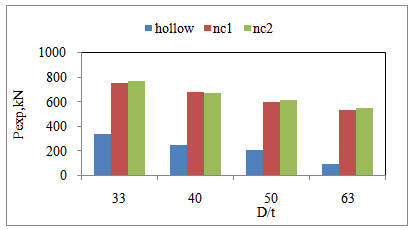 | Figure 1. Variation of Axial Load Capacity of hollow and CFT columns |
3.2. Estimation of Axial Load Capacity and Confinement Effect
- The axial load capacity of CFTs and confinement effect of concrete core is estimated using design methods suggested by various authors (the relevant equations are available in literature) [4, 8, 9].
3.2.1. Estimation of Theoretical Axial Load Capacity
- The theoretical values of axial load capacity (Ptheo) of CFTs are obtained by adding steel and concrete contribution of loads. Figure 2 shows the variation of experimental axial load capacity (Pexp) values of CFTs compared to theoretical estimation with respect to diameter to thickness ratio. The estimated values are conservative by 27-37%. The deviation of estimated values from that of experiment is more for CFT columns of lesser D/t ratio which implies that confinement effect is more pronounced in such columns.
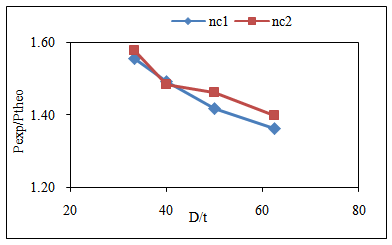 | Figure 2. Pexp/Ptheo versus D/t |
3.2.2. Estimation of Axial Load Capacity as per Equation Suggested by Mander et al
- The values of axial load capacity of CFTs are obtained using the method suggested by Mander et al., [9], (Pman) which includes confinement effect in the estimation by replacing unconfined compressive strength by compressive strength of confined concrete in the calculation of concrete contribution. Figure.3 shows the variation of experimental axial load capacity (Pexp) values of CFTs compared to estimated values as per equation suggested by Mander et al., [9], (Pman) with respect to diameter to thickness ratio. The estimated values are conservative by 19-28%. Figure 4 shows the variation of compressive strength of confined concrete (fcc) values of CFTs with respect to diameter to thickness ratio and it is found to be decreasing (by 8.7%) with increase in diameter to thickness ratio. This indicates that axial load capacity of CFT columns of lesser D/t ratio is influenced by confinement effect of concrete core.
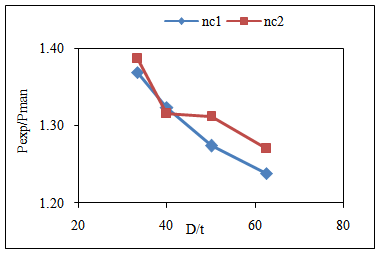 | Figure 3. Pexp/Pman versus D/t |
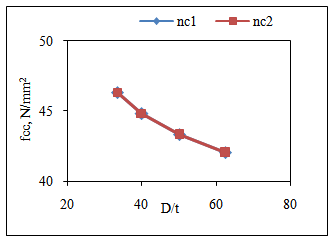 | Figure 4. Variation of Confined Compressive Strength |
3.2.3. Influence of Concrete Confinement in CFTs
- Figure 5 shows the variation of percentage confinement of concrete in CFTs with respect to diameter to thickness ratio. These values are calculated as ratio of difference in test and theoretical value of axial load capacity to theoretical capacity of CFTs (as per Gupta et al.), [8]. These values are found to be decreasing (by 36%) with increase in diameter to thickness ratio from 33 to 63. Figure 6 shows the variation of concrete enhancement factor (Giakoumelis and Lam, Umamaheswari et al.), [4, 10] with respect to diameter to thickness ratio. These values are found to be decreasing (by 26%) with increase in diameter to thickness ratio.
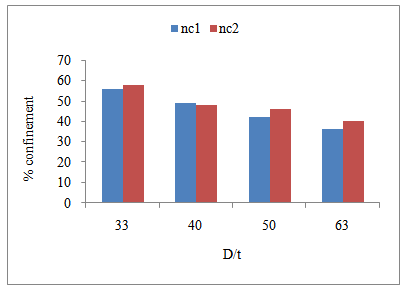 | Figure 5. Variation of Percentage confinement in CFTs (w.r to D/t) |
 | Figure 6. Variation of Concrete Enhancement Factor (w. r to D/t) |
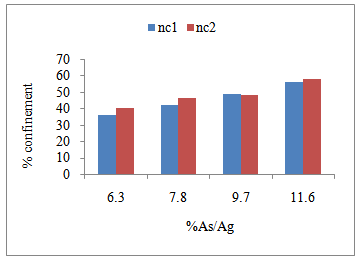 | Figure 7. Variation of Percentage confinement in CFTs (w.r to %As/Ag) |
 | Figure 8. Variation of Concrete Enhancement Factor (w.r to %As/Ag) |
4. Conclusions
- Cold-formed steel circular column specimens (twelve no.s) of similar length to diameter ratio and varying diameter to thickness ratio are tested till failure and tested axial load capacity values are compared with the values estimated by using methods (suggested by various authors) available in literature. The conclusions arrived within the scope of these tests are as follows,• The axial load capacity is found to be decreasing with increase in diameter to thickness ratio for both bare steel and CFT columns. Concrete filling enhances the axial load capacity of identical steel hollow tubes by up to 2.2 to 5.5 times based on diameter to thickness ratio. • The estimated values of axial load capacity from method under consideration are found to be conservative for all columns by up to 37%. The method suggested by Mander et al. [9] includes confinement effect of concrete core and yet the results of CFTs under consideration are conservative by upto 28%. • The percentage confinement in CFTs and the Concrete Enhancement Factor is found to be decreasing by 36% and 26% respectively, with increase in D/t ratio from 33 to 63. Also, the percentage confinement in CFTs and the Concrete Enhancement Factor is found to be increasing by 55% and 35% respectively, with increase in steel area contribution from 6.3 to 11.6. • Overall the deviation of estimated axial load capacity values from experimental values is high for CFT columns of lower D/t ratio and larger steel area contribution. Hence it can be concluded that confinement is more effective in columns of comparatively lower D/t ratio and thicker tubes. This needs further investigation.
ACKNOWLEGEMENTS
- The authors wish to thank the Management of SRM University for providing financial support and facilities to carry out the research work.
 Abstract
Abstract Reference
Reference Full-Text PDF
Full-Text PDF Full-text HTML
Full-text HTML